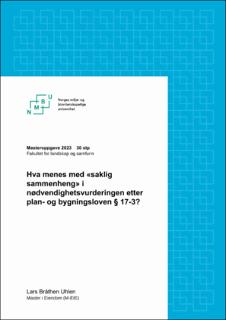| dc.contributor.advisor | Fredrik Holth | |
| dc.contributor.author | Uhlen, Lars Bråthen | |
| dc.date.accessioned | 2023-07-15T16:28:26Z | |
| dc.date.available | 2023-07-15T16:28:26Z | |
| dc.date.issued | 2023 | |
| dc.identifier | no.nmbu:wiseflow:6839533:54591862 | |
| dc.identifier.uri | https://hdl.handle.net/11250/3079322 | |
| dc.description.abstract | Oppgaven består av totalt ti kapitler. Teoridelen av oppgaven, som omfatter kapittel to til seks, har som overordnet formål å presentere de rettslige skrankene som gjelder for bruken av utbyggingsavtaler. Denne delen av oppgaven er skrevet med utgangspunkt i rettsdogmatisk metode, hvor lovtekst, forarbeider, rettspraksis og litteratur legges til grunn for tolkningen av gjeldende rett.
Oppgavens hovedfokus er hva som legges i saklig sammenheng i nødvendighetsvurderingen etter plan- og bygningsloven § 17-3 tredje ledd. Dette blir gjennomgått i kapittel syv, og baseres på kapittel fire til seks. Bestemmelsen er nært knyttet til plan- og bygningsloven § 12-7 nr. 10, som regulerer adgangen til å vedta rekkefølgebestemmelser. Dette blir redegjort for i kapittel fem.
I kapittel seks vil jeg gjennomgå mortensrudsaken. Saken gikk hele veien til Høyesterett, hvor dom ble avsagt i mai 2021. Dommen handler om hvilken sammenheng det må være mellom rekkefølgekrav og en utbygging, og er derfor sentral for å besvare denne oppgavens problemstilling.
I kapittel 8 ser jeg på hvordan det rettslige kravet til saklighet har blitt lagt til grunn i praksis. Her undersøker jeg kommunens begrunnelser for rekkefølgekravet, og anvender deretter de vurderingstemaene for saklighet jeg presenterte i kapittel 7 på et utvalg utbyggingsavtaler inngått i Oslo kommune. Avslutningsvis følger mine egne refleksjoner i kapittel 9. | |
| dc.description.abstract | The master’s thesis consists of a total of ten chapters. The theory of the thesis, which includes chapters two to six, has the overall purpose of presenting the legal counters that apply to the use of development agreements. This part of the thesis has been written based on the legal dogmatic method, where legal text, preparatory work, case law and literature are used as a basis for the interpretation of current law.
The task's main research question is what is put into “factual context” in the assessment of necessity according to Section 17-3 third paragraph of the Planning and Building Act. This is reviewed in chapter seven, and is based on chapter four to six. The provision is closely linked to the Planning and Building Act section 12-7 no. 10, which regulates the right to adopt order regulations. This is explained in chapter five.
In chapter six, I will review the Mortensrud case. The case went all the way to the Supreme Court, where judgment was handed down in May 2021. The judgment deals with the question of what connection there must be between sequence requirements and a development, and is therefore central to answering this thesis' problem.
In chapter 8, I look at how the legal requirement for factual connection has been practiced by the municipality. Here I examine the municipality's justifications for the sequence requirement, and then apply the assessment themes for objectivity that I presented in chapter 7 to a selection of development agreements in Oslo municipality. In conclusion, my own reflections follow in chapter 9. | |
| dc.language | nob | |
| dc.publisher | Norwegian University of Life Sciences | |
| dc.title | Hva menes med "saklig sammenheng" i nødvendighetsvurderingen etter plan- og bygningsloven § 17-3? | |
| dc.type | Master thesis | |
